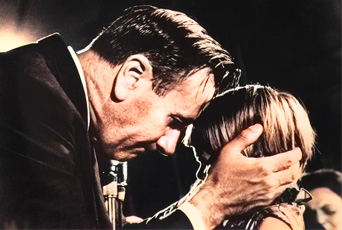THE HEALING MINISTRY OF JESUS IN THE GOSPELS
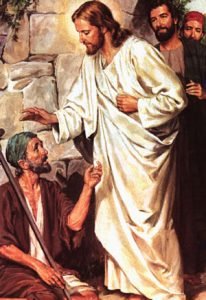
Jesus healing a beggar
There is clear testimony in the Gospels that Jesus practiced healing. Wherever he went he ministered healing to hurting people. Though there are only forty-one distinct instances of physical or mental healing recorded in the four Gospels, the texts record innumerable cures that took place during his 3½ year ministry. Many of the references summarise the healing of large numbers of people. The Authorised Version repeatedly refers to ‘multitudes’ who followed and observed Jesus ministry and ‘multitudes’ who were healed by Jesus Mt 12:15, 19:2. The NIV rather inadequately employs ‘many’ or ‘crowds’ which doesn’t really do justice to the Greek words used. The 41 more detailed accounts are simply the ones that their writers considered the most appropriate and helpful to their hearers.
After observing the healing ministry of Jesus first-hand for thirty months John writes:
“Many other signs therefore, Jesus also performed in the presence of the disciples, which are not written in this book: but these have been written that you may believe that Jesus is the Christ, the Son of God; and that believing you may have life in His name.” John 20:30-31 “And there are also many other things which Jesus did, which if they were written in detail, I suppose that even the world itself would not contain the books which were written.” John 21:25
Nearly one-fifth of the Gospel accounts is devoted to Jesus’ healing ministry, including the circumstances, the methods used and the effects on the patients and those who were onlookers. Out of 3,779 verses in the four Gospels, 727 relate specifically to the healing of physical and mental illness and the resurrection of the dead. It should be noted that the attention given to the healing ministry of Jesus is far greater than any one kind of experience recorded, including salvation.
THE HEALING MINISTRY OF JESUS
| Description | Matthew | Mark | Luke | John |
|---|---|---|---|---|
| 1. Man with unclean spirit | 1:23 | 4:33 | ||
| 2. Peter’s mother-in-law | 8:14 | 1:30 | 4:38 | |
| 3. Multitudes | 8:16 | 1:32 | 4:40 | |
| 4. Many demons | 1:34 | |||
| 5. Leper | 8:2 | 1:40 | 5:12 | |
| 6. Man with palsy | 9:2 | 2:3 | 5:18 | |
| 7. Man with withered hand | 12:10 | 3:1 | 6:6 | |
| 8. Multitudes | 12:15 | 3:10 | ||
| 9. Gadarene demoniac | 8:28 | 5:1 | 8:26 | |
| 10. Jairus’ daughter | 9:18 | 5:22 | 8:41 | |
| 11. Woman with issue of blood | 9:20 | 5:25 | 8:43 | |
| 12. A few sick people | 13:58 | 6:5 | ||
| 13. Multitudes | 14:34 | 6:55 | ||
| 14. Syrophoenician’s daughter | 15:22 | 7:24 | ||
| 15. Deaf and dumb man | 7:24 | |||
| 16. Blind man | 8:22 | |||
| 17. Child with evil spirit | 17:14 | 9:14 | 9:38 | |
| 18. Blind Bartimaeus | 20:30 | 10:46 | 18:35 | |
| 19. Centurion’s servant | 8:5 | 7:2 | ||
| 20. Two blind men | 9:27 | |||
| 21. Dumb demoniac | 9:32 | |||
| 22. Blind and dumb demoniac | 12:22 | 11:14 | ||
| 23. Multitudes | 4:23 | 6:17 | ||
| 24. Multitudes | 9:35 | |||
| 25. Multitudes | 11:7 | 7:21 | ||
| 26. Multitudes | 14:14 | 9:11 | 6:2 | |
| 27. Great Multitudes | 15:30 | |||
| 28. Great Multitudes | 19:2 | |||
| 29. Blind and lame in Temple | 21:14 | |||
| 30. Widow’s son | 7:11 | |||
| 31. Mary Magdalene and others | 8:2 | |||
| 32. Woman bound by Satan | 13:10 | |||
| 33. Man with dropsy | 14:01 | |||
| 34. Ten lepers | 17:11 | |||
| 35. Malchus’ ear | 22:50 | |||
| 36. Multitudes | 5:15 | |||
| 37. Various persons | 13:32 | |||
| 38. Nobleman’s son | 4:46 | |||
| 39. Impotent man | 5:2 | |||
| 40. Man born blind | 9:1 | |||
| 41. Lazarus | 11:1 |
Jesus began healing after his baptism and anointing by the Holy Spirit (Luke 3:21, 22; 4:1-19. He delivered all who came to him from every kind of sickness (Mark 7:31-37), demonic possession and related effects (Matthew 17:14-21), and even physical death (John 11:43, 44).
1. Demonic issues
The first healing encounter that Jesus experienced was with a man who had a demonic problem. Mk 1:29. The writers list the sick and the demonized amongst the multitudes that were healed Mk 1:32, 34. Sometimes this demonization had psychotic or antisocial symptoms Mk 5:1-20 and other times the demonic influence was sickness, dumbness Mt 9:32, blindness Mt 12:22, extreme curvature of the spine Luke 13:10ff, something similar to epilepsy Mk 9:17-27.
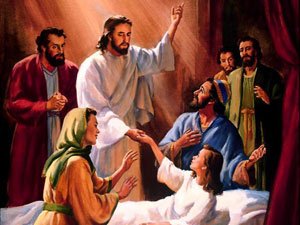
Jesus raising a dead child
2. Skin diseases
There are a number of references to ‘leprosy’ being healed Mt 8:2-4, Mark 1:4 and Luke 17:12-15, though some believe that this leprosy was a generic term which included all types of skin disease.
3. Immobility
There are a number of examples of the healing of lameness, palsy or paralysis, and other crippling infirmities. Mt 9:2-7, Mark 2:3-4, Luke 5:18-19.
4. Fever
Matthew 8:14-15, Mark 1:30-31, and Luke 4:38-39 record the healing of Peter’s mother-in-law and the nobleman’s son also had a fever. Jn 4:47-53.
5. Blindness
Blindness was another common complaint in the Roman world. The man born blind Jn 9, the well know story of Bartimaeus in Mark 10:46-52 and Luke 18:35-42, the man brought to Jesus at Bethsaida in Mark 8:22-25; the two blind men in Matthew 9:27-30 and another two in Matthew 20:30-34.
There are more healings recorded in the Gospels but this brief list serves to show the diverse nature of the sicknesses Jesus dealt with. Besides all these stories of individuals there are also nineteen places in the first three Gospels where it says that numbers of people were healed, without much detail regarding the diseases that were healed.
HOW DID JESUS HEAL?
Compassion
The Gospel writers often introduce Jesus attitude to the sick as one of compassion. He had compassion for crowds Mt 9:36; 14:14, as well as pity on two blind beggars Mt 20:34. Right from the outset Jesus compassion is highlighted at a motivating factor in Jesus ministry of healing. Mk 1:4.
Faith
Faith is the most recorded quality connected with the impartation of healing power. Jesus seemed to be more able to heal in the presence of faith, as illustrated by his experience in his own home town Lk 4:23-28 and at Nazareth Mk 6:1-6; Lk 4:23-28.
He was especially moved by the “great faith” of the centurion Mt 8:5-13. He observed supernaturally the faith of the “stretcher carriers” as they carried the paralytic and lowered him into the room where Jesus was preaching Mk 2:1ff. Other examples are the blind men Mt 9:27-31; the haemorrhaging woman Mk 5:25ff; the father of the demoniac boy Mk 9:14-29. He was always willing to heal those who came to him with faith as did the leper Mt 8:1-4, the centurion’s servant (Mt 8:5-13, and the Syrophoenician woman’s daughter Mk 7:24-30.
WHAT METHODS DID JESUS USE TO HEAL?
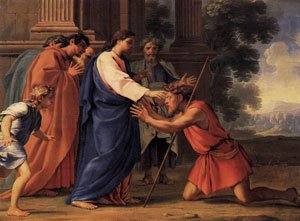
Jesus healing a blind man
Frequently the Lord would heal many people, one after another, in large meetings or gatherings (Matthew 4:23-25; 14:13, 14; 15:30, 31), but would not do miracles for those who only wanted to test him or be entertained e.g., the Scribes and Pharisees—Matthew 12:38-42.
Touch
Peter’s mother-in-law was touched on the hand Mt 8:15. Sometimes it was someone touching him, like the “many” in Mt 14:34-36; and the haemorrhaging woman in Lk 8:42-48
Command
He would often speak a word of command like “Go” to the centurion Mt 8:5-13;”Rise” to the paralytic Lk 5:17-26; “Stretch out” to the man with the withered hand Lk 6:6-10; and “Arise” to the son of the widow in Nain Lk 7:11-17).
Sometimes his pattern would include both a touch and command as with the leper Lk 5:12-16.
Spit
On some occasions he used spittle or mud – deaf and dumb – Mk 7:31-37; blind man – Mk 8:22-26; blind man – Jn 9:6, 7.
Acts of faith
Often he required those being prayed for to perform some act of faith. Some examples are: “Stretch out your hand,” to the man with the withered hand Lk 6:6-10; “Go wash,” to the blind man Jn 9:7; and “Go, show yourself to the priest,” to the ten lepers Lk 17:11-19.
Prayer
At other times it was a prayer as with Lazarus Jn 11:41-42.
Jesus often interacted with those he ministered to. He asked the blind man, “. . .Do you see anything…?” Mk 8:22-26; Of the Gerasene demoniac he asked, “. . . What is your name…?” Mk 5:1-13; to the father of the demoniac boy he asked, “. . . How long has he had this. . . ?” Mk 9:14-29; of Bartimaeus he asked, “What do you want me to do for you?” Mk 10:46-52.
Jesus frequently directed the ones he healed to get “medical proof” (see Leviticus 13:49; 14:2-32), and was positive about the work of the physicians. Some examples are: the leper Mt 8:1-4; the ten lepers Lk 17:11-19; need of a physician Mk 2:17
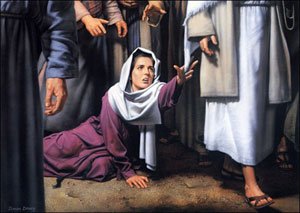
The bleeding woman touches His clothes for healing
Sometimes Jesus had to pray more than once for the needy person to be healed e.g., the blind man of Bethsaida – Mk 8:22-26. He continued to pray for the Gerasene demoniac. The word translated “he had been saying” (NAS) elegen, is an imperfect active indicative. The kind of action the verb has is continuous action. He frequently delivered the demonized and healed them of related effects using various patterns. He demanded the demons’ names in Mark 5:1-13; he required silence from the demons in Luke 4:31-37; 40-41; and cast them out with a command (Luke 4:35, 36). Finally he issued very strong warnings against labeling healing done in his name and by his Spirit as demonic in origin. Such words would blaspheme the Spirit and could move him to permanent wrath! e.g., Pharisees blasphemy of Spirit – Mark 3:20-30.
FOUR IMPORTANT ASPECTS OF JESUS’ LIFE
(From John Wimber’s Signs and Wonders Conference notes 1984)
1. HIS RELATIONSHIP WITH THE FATHER
Jesus, the eternal Son of God, became flesh. The secret of the sinless life of Jesus and his miraculous ministry is grounded in his relationship to the Father. Even though he was God, Jesus drew his power from an intimate, child-like relationship with the Father in heaven. The ability to hear what God is saying, to see what God is doing, and to move in the realm of the miraculous comes as an individual develops the same intimacy with and dependence upon the Father. How did Jesus do what he did? The answer is found in his relationship with the Father. How will we do the “greater works than these” which Jesus promised? By discovering the same relationship of intimacy, simplicity and obedience.
John shows the nature of this relationship and how the ministry of Jesus flowed out of it. In John 1:1, he tells (us) Jesus’ relationship with the Father has always been (was—imperfect tense). This relationship, he goes on to show, was continued on earth. John also shares in 3:10-13 that Jesus speaks of what he knows (oida – knowledge through experience). His speaking flows out of his experience with the Father. Jesus works together with the Father; he does nothing on his own initiative. He acts and speaks only what he sees the Father doing (John 5:17-21). This brief overview emphasizes the relationship of the Father and the Son. John has more to say on the subject which is well worth studying.
2. HIS RELATIONSHIP WITH THE HOLY SPIRIT
The Holy Spirit is that sovereign member of the Godhead who comes to indwell the Christian’s life. Although his work is manifold, one indispensable reason for his presence in the Christian’s life is to give power. The role of the Holy Spirit in the ministry of the Christian is covered most sensitively and perceptively in Luke’s Gospel. The Spirit is the Christian’s sole resource for supernatural power in doing the work of God. Luke is careful to record this role of the Holy Spirit in the life of Christ. He leaves no room for doubt that the Holy Spirit alone is the key to Jesus’ power and effectiveness in his ministry. Review these passages in Luke covering Jesus’ preparation for ministry: Luke 3:21-23; 4:1, 14, 18; 5:17.
Five times in just a few paragraphs, Luke gives us vital information about the relationship of the Holy Spirit to Jesus. These opening paragraphs show the launching of Jesus into his ministry. He preached and healed by the power of the Holy Spirit. The Holy Spirit healed through Jesus in the same way he heals through us.
3. HIS PRAYER LIFE
Prayer as it relates to healing is stressed throughout the New Testament. It was particularly marked in the life of Jesus. On one occasion Jesus inferred that prolonged (rather ‘intensified by fasting’ TC) prayer may be a necessary element in very difficult cases of healing (Mark 9:29). It is interesting to trace prayer in the life of Christ, especially as it relates to his healing ministry. Luke seems to make a point in this regard. We have already noted Luke’s captivation with the relationship between Jesus’ ministry and the Holy Spirit. He seems to imply the same in regard to prayer. At Jesus’ baptism Luke says that Jesus was praying. Before Jesus launched into his ministry, he spent forty days in the wilderness fasting and praying (Luke 4:1-13). The next mention of prayer by Luke is of Jesus getting up early in the morning for a quiet time alone with God prior to a very crowded and busy schedule of ministry (Luke 4:42). Then he tells us about the crowds of people that came to hear Jesus and to be healed, and how he withdrew from them to pray (Luke 5:15). Jesus prayed all night before selecting the twelve apostles whom he sent out to preach and to heal (Luke 6:12-16).
The vital relationship between the prayer life of Jesus and his power-filled ministry, both in teaching and in healing, provides a helpful model for the Church today. Good preaching, to some extent at least, can be developed through close study and application of sound principles of speech, homiletics and communications; but the awesome demands of ministering to someone who is hurting can only be met by an active and believing prayer life. Learning to use the weapon of prayer in the healing ministry is certainly not unrelated to other aspects of the Christian life. The failure to be actively engaged in one aspect of the Christian life tends to affect the whole. Active, believing prayer included in the ministry of Christian healing will add a new vibrancy to all aspects of the life of the Church.
4. HIS PERSPECTIVE OF SICKNESS
Jesus was motivated to heal men not only because of his love for them, but also because of his hatred of the forces that bound man. A word of rebuke was often on the lips of Jesus when he was dealing with demons. The first demon Jesus met at the beginning of his ministry started to scream, until Jesus rebuked him (Luke 4:35). Jesus did this on other occasions, once even rebuking a fever as if it were an animate thing that could respond to the orders of Jesus (which it did, Luke 4:39). Another time Jesus rebuked the elements of nature that were about to sink the boat he and the disciples were in (Luke 8:24).
There is other evidence that Jesus was hostile to the forces of evil besides the specific use of the word “rebuke.” One instance of this comes from Mark 3:1-6. Here we see Jesus in a synagogue on the Sabbath day. A man with a paralyzed hand was there. The Pharisees were watching to see if Jesus would heal on the Sabbath. Jesus called the man to come up front and told him to stand there. He then turned to his antagonists and asked them if the Law permitted one to do good on the Sabbath. Phillip’s New Testament says: “There was a dead silence.” Then Jesus, deeply hurt as he sensed their inhumanity, looked around in anger at the faces surrounding him, and said to the man, “Stretch out your hand.” Here we find one of the few times when Jesus is said to be angry with their lack of compassion. Kelsey says the following, “Jesus’ underlying attitude was that the demon-possessed and the physically ill were under the influence or control of an evil power. Some evil source – demons, Satan, something destructive and uncreative – the very opposite of the Spirit, seemed to have gained control or at least a partial influence over the sick person. Since Jesus by his very nature was opposed to this power and hostile to it, he wanted to bring it into subjection and in that way to free man (Kelsey 1973, 89-90).
Jesus healed because he was opposed to anything which bound or enslaved men. He recognized that the forces of darkness were in some way connected with man’s physical infirmities, and in opposing these infirmities, he was in essence showing his opposition to Satan and his kingdom.
Bibliography: Morton Kelsey, Healing and Christianity (1973); John Wimber’s Conference notes (1984)
Tony Cauchi
November 2011


